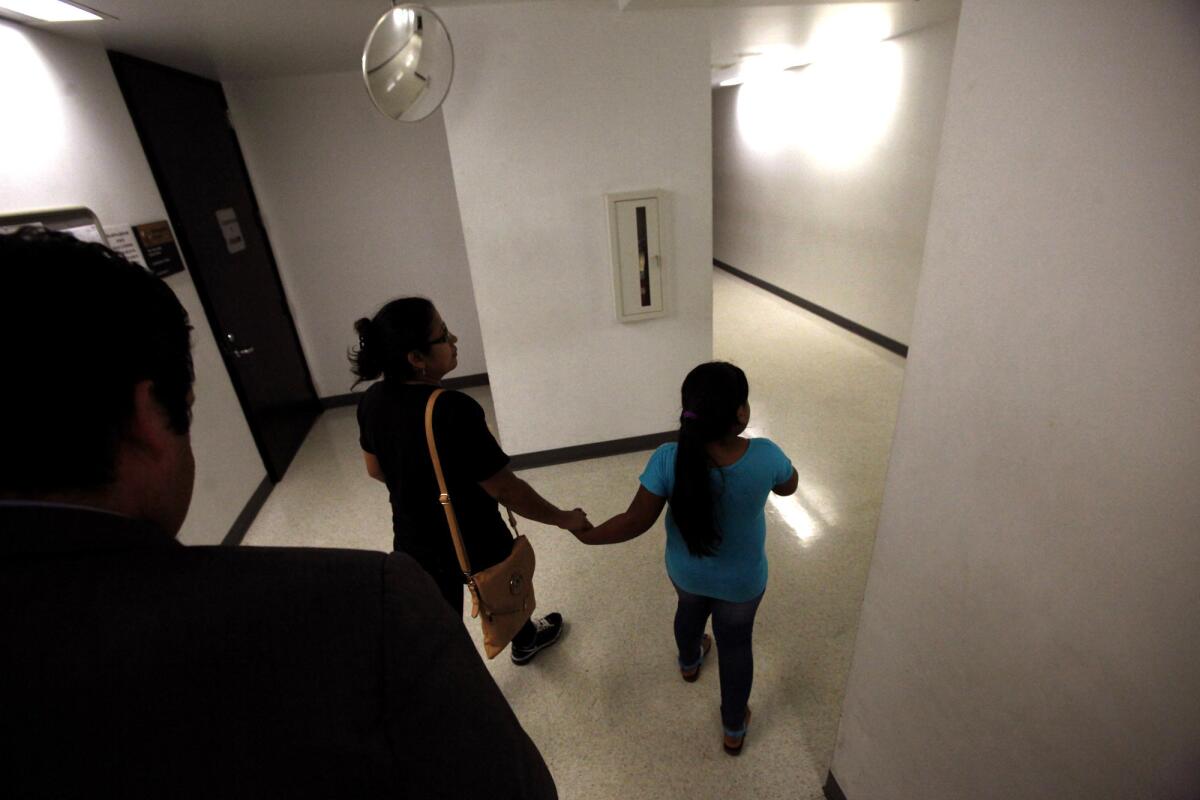As immigration judges’ working conditions worsen, more may choose retirement

Dayana Varela, 9, her mother, Silvia Padilla, and their attorney Alex Olguen leave an immigration court hearing in Los Angeles last year on an application for political asylum. There’s a growing backlog of cases in immigration courts nationwide.
Immigration Judge Eliza Klein had more than 20 years’ experience hearing cases in Boston, Miami and, most recently, Chicago when a surge of immigrants arrived last summer. In addition to the backlog of cases she already faced, Klein started seeing more Central American youths seeking asylum.
“I just really didn’t like telling these young kids they had to go back to this situation. It really was very stressful for me and distressing,” she said. “I started out my career representing people with asylum claims, and a lot of those were Central American. I didn’t want to sign my name on something and send someone back somewhere where they could potentially lose their life.”
Klein, 62, was also a mother with a daughter finishing college.
“I had teenagers from Honduras crying to me, ‘Why am I in jail? I didn’t do anything wrong.’ I had to explain to people why, but I couldn’t justify it. I couldn’t say that to these kids,” Klein said.
In January, she retired.
There are 247 immigration judges in 58 courts nationwide, and more than half of them, 130, are eligible to retire this fiscal year, which ends Sept. 30.
The U.S. attorney general appoints immigration judges. Officials have already started “an aggressive hiring process,” said Kathryn Mattingly, an immigration court spokeswoman. They have hired 18 judges, five more will start this fiscal year, and they plan to hire an additional 67, she said. Last fiscal year, about 100 judges were eligible to retire, but only 13 did, she said.
Working conditions for judges grow progressively worse each year, Klein said, and that could lead to more retirements.
Though other kinds of judges usually handle 500 cases a year, immigration judges typically handle more than 1,400, and some juggle more than 3,000, according to the Immigration Policy Center.
Immigration judges face a backlog of more than 450,000 cases that has more than doubled during the last decade, according to Syracuse University’s Transactional Records Access Clearinghouse. During that time, the number of judges increased about 20% and the average wait time increased 65%. The longest average wait this year: Denver, 877 days.
“Clerks can’t keep up with this workload, and it’s just unreasonable,” Klein said. “The agency has expanded the number of judicial law clerks so the judges are able to do research for cases and have law clerks draft decisions for them. But we’ve had hiring freezes for years.”
Adding to the strain, newly arrived immigrant children and families have been fast-tracked in “rocket dockets,” delaying other cases until 2019.
“Why immigration judges get burned out is they have a high volume of cases, some on their dockets for years, and then those cases get pushed out because somebody in Washington says these other cases matter more,” Klein said. “When I started, the longest you would put a case out for was six months.… If you have to put a case out more than a year, you lose the ability to retain that sense of what the case is all about.”
Even fast-tracked cases often get delayed as immigrants try to navigate a legal system in which, unlike criminal court, they are not entitled to public defenders.
“We have a judge in Chicago who is handling thousands of these cases. Frequently they don’t show up at their hearings, but we don’t know why — maybe the person who is supposedly their guardian doesn’t know. So those cases can’t move forward,” Klein said.
It’s frustrating to watch the delays benefit those without legitimate reason to stay legally, Klein said, while “people who are eligible, they get stuck in limbo.”
The cases are also emotionally taxing, she said.
“You hear these devastating stories of people who maybe have been tortured or fled severe conditions: political-related violence, gang violence. You have to listen intently and see, is this person telling the truth? It’s very draining. A lot of judges have sort of post-traumatic stress.”
Immigration judges suffer burnout rates higher than prison wardens and doctors, according to a 2007 survey of the National Assn. of Immigration Judges by psychiatrists at UC San Francisco.
Judges said they had little time to think, let alone research complex cases. One immigration judge wrote in the survey, “I am OUTRAGED by the fact that Department of Homeland Security asylum officers receive more time to keep current on country conditions and changes in the law than we do.... The law has gotten exponentially more complex while the time pressures and resources (like law clerks) inversely diminished.”
Judges reported that they faced chronic shortages of staff, office space and technology.
“I have been in government service for decades, including combat duty, and I have never detested a working environment more than I do in this capacity,” one judge told the researchers.
The courts have tried short-term fixes: adding temporary judges, temporarily assigning judges to higher-volume areas, or having them hear cases via video.
But Klein said video hearings can be even more frustrating, limiting judges’ ability to interact with and gauge the veracity of immigrants and witnesses.
Judge Dana Leigh Marks, president of the judges association, called overwork and understaffing “chronic.” Marks, who is based in San Francisco, knows numerous judges like Klein who have retired or are considering it at the peak of their careers because of worsening conditions.
Marks said the Justice Department has started to address the problem, but “we’re a long way from where we need to be” and it needs to hire at least 100 more judges “immediately.”
Last week, she attended a national immigration judges’ training conference in Crystal City, Va., the first in five years because of funding.
“Morale is improved,” she said, but “we are still treading water in a rip current. The longer we do that, the more fatigued and stressed people get.”
Klein knows some people applying to become judges, considers them well-qualified and hopes they can improve the system.
“It will always be a very difficult job, but also very rewarding,” she said.
Klein has returned to private practice, representing immigrants. Next month, she plans to travel to the detention center in Dilley, Texas, to volunteer representing migrant families.
Twitter: @mollyhf
MORE ON IMMIGRATION:
Young immigrants placed in sponsor homes are at risk of abuse, experts say
Paid $1 to $3 a day, unauthorized immigrants keep family detention centers running
Latest complaint on family detention: Few Spanish-speaking staffers
More to Read
Start your day right
Sign up for Essential California for news, features and recommendations from the L.A. Times and beyond in your inbox six days a week.
You may occasionally receive promotional content from the Los Angeles Times.







